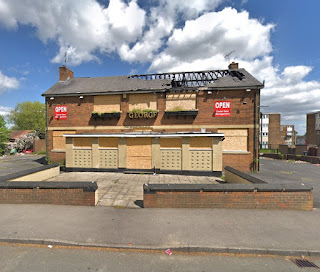I haven’t done any travelogues on here for a while, but I thought I’d make an exception for my trip to Leeds on Tuesday of this week. Apart from a brief foray for the press launch of Tetley’s No.3 Pale Ale (and whatever happened to that?) I hadn’t visited the city since December 2016, so I thought it was time for another exploration.
I sat down on my train from Manchester Piccadilly, only for a message to come over the PA that it had been cancelled due the lack of a driver. The next train was one that look the longer route via Manchester Victoria, and would probably be very busy due to the transferring passengers, so I took the opportunity to get on a stopping train which arrived at Huddersfield just before the express. Indeed there were plenty of seats available on this. For some reason the regular stopping service on the Standedge route, previously operated by Northern Rail, has been discontinued, and replaced with a rather intermittent service operated by Trans-Pennine Express calling at the intermediate stations. But it does give a higher standard of rolling stock.
It was a morning of heavy rain and thick, lowering clouds, so as we travelled along the steep-sided valleys of the Tame and Colne, stopping at Mossley, Greenfield, Marsden and Slaithwaite (correctly pronounced by the conductor) it was rather like a train journey into the depths of Mordor. The connection at Huddersfield was duly made, and there were a few seats still available on the express, which arrived in Leeds on time. I duly submitted my claim for compensation to the train operator and am pleased to report I was promptly refunded a quarter of the fare.
My plan had been to have some lunch in the Wetherspoon’s on the concourse of Leeds station, but this must be one of their smallest branches, and was completely full, so instead I decided to go to the Cuthbert Brodrick, which is about ten minutes’ walk away on the north side of the city centre. It was pouring with rain, so I just took a quick glance at Google Maps on my phone to establish its general whereabouts. I was walking up a street and saw a large red-brick building on my left, with the Wetherspoon’s name displayed on the wall, so I dived in out of the rain, found a seat and placed my order via the app.
Twenty minutes later, nothing had arrived, so I mentioned this to a passing member of staff and was assured in a rather offhand way that the kitchen would still be making it. Another twenty minutes passed, so I went up to the bar to complain. “We’ve got no record of any order being placed from that table,” I was told. So I showed them the confirmation e-mail on my phone, only to be told that, while I had indeed placed my order at the Cuthbert Brodrick, the pub I was in was actually the Hedley Verity.
Feeling a touch embarrassed, I duly decamped to the Cuthbert Brodrick, which is in fact only about two hundred yards away. I explained the situation to the staff there, and in fact the drink I had ordered was still on the bar. I found a table and my food was served fairly quickly, so kudos to them for sorting matters out. Possibly they had noticed the table was empty when delivering the drink, and then not actually cooked the food, as it didn’t seem as though I’d been given something that had been warmed up again. I suspect I’m not the first person to make this mistake when two branches are so close together.
Named after the local Victorian architect, the Cuthbert Brodrick is a modern Wetherspoon’s with an unusual corner tower, built on the site of former public baths and overlooking the city’s Millennium Square. While wide, it’s fairly shallow, with the ground floor mainly occupied by posing tables, but more comfortable seating upstairs. Not the most memorable of Spoons, but it had served its purpose in the end. Last time in Leeds we had eaten at Friends of Ham, which I thought was very good, but I don’t think their formula works so well for a solo diner. And, as I said on Twitter:
So far, I had felt rather like Unlucky Alf from the Fast Show, but things were to get a lot better. Walking past the impressive classical façade of Leeds Town Hall, designed by the said Cuthbert Brodrick, brought me to the Town Hall Tavern. This is a Timothy Taylor’s tied house with a fairly functional one-room interior, offering the full range of their regular beers – Dark Mild, Golden Best, Boltmaker, Knowle Spring, Landlord and Landlord Dark. I went for the Landlord Dark (£4.50), as I’d never had it before on cask, and it was pretty good. In mid-afternoon, it wasn’t busy, but there were a group of lawyers talking shop. Perhaps not the most scintillating of conversations to eavesdrop on, but it’s good to see the tradition of professional people discussing business over a pint still being maintained.Wetherspoon’s have become so well-known and ubiquitous that, in an unfamiliar town, it’s very easy to make them the default choice for a pub meal, rather than trying to find somewhere else.
— Pub Curmudgeon 🌸🍻 (@oldmudgie) October 26, 2023
There followed a long walk up The Headrow, the wide main street running through the middle of the city centre, although the rain was now easing off. The next pub was the Templar, which I had heard many good things about, and which didn’t disappoint. It’s a long, shallow corner pub with an elaborate tiled façade. Inside, while it has been opened out somewhat, it retains plenty of historical character, with wood panelling, seating booths and a cosy snug right at the far end. It was very busy, with the clientele leaning towards the older male end of the spectrum, although with both sexes and a variety of age groups represented, but I managed to find myself a seat with a good vantage point.
Although owned by Greene King, this isn’t at all obvious, and indeed I don’t think any of the eight cask ales on offer were their products. Apparently it regularly stocks Tetley Bitter, but I overhead a customer asking about it and being told it wouldn’t be available for a couple of days. I plumped for Acorn Barnsley Bitter, a bargain at £3.36, which was very good indeed. Apparently it’s one of the pubs that still uses Autovac dispense. A splendid pub with a great atmosphere, that’s certainly the best new pub I’ve visited this year and immediately shoots into my all-time Top 20.
Retracing my steps, I passed the Three Legs, which has an impressive façade and a reputation for being distinctly “lively”, although as it is reported to have no cask beer I gave it a miss. By this time the rain had fortunately stopped. Briggate, which runs North to South, was Leeds’ original high street, and still retains several Victorian shopping arcades together with four pubs on the west side situated in courtyards accessed via narrow alleyways. I had previously visited Whitelock’s and the Angel, so today decided to try the other two.
First was the Ship, which is the smallest of the four. This is reached by a very narrow passage, and is made up of a room containing the bar, and a further seating area at a slightly higher level. A good scattering of customers, and a decent drop of Black Sheep Bitter at £4.30. I walked straight past the entrance to the Pack Horse before realising I’d reached Whitelock’s and turning back. A Craft Union pub, this is rather more spacious, with the bar against the back right-hand wall. Again it was ticking over nicely, although not heaving, and offering Landlord at the bargain price of £2.90.
Neither of these are going to win prizes for historic interiors, but it’s good to see a couple of unassuming pubs hidden away down passageways thriving in such a central location. The gem of the four is of course the well-known Whitelock’s, which may well merit a visit next time. It might be nice if Timothy Taylor’s could acquire either the Ship or the Pack Horse to give them a better Leeds flagship than the rather ordinary Town Hall Tavern.
Continuing to the south, I crossed the bridge over the River Aire, somewhat swollen by the recent rains, to reach the Adelphi, an impressive Victorian pub with a curved façade, the neon sign on the roof of the former Tetley’s brewery clearly visible in the distance. This is the only pub that I also visited on my previous trip, but it features a stunning unspoilt interior that qualifies it for a three-star entry on CAMRA’s National Inventory, with four separate rooms ranged around the central part, and an abundance of frosted glass and wood panelling.
It wasn’t anywhere near as busy as the previous time, although that was later in the year in the run-up to Christmas, and I had no problem finding a comfortable seat. I had a pint of Leeds Pale and then, looking at the times of the return trains, slotted in another of Titanic Plum Porter. These were respectively £4.85 and £5.25, and this was the first time I have ever paid over £5 for sub-5% beer, although I’m sure it won’t be the last. I’ve seen the point made before that, while the Adelphi has stunning architecture inside and out, the actual pub experience doesn’t quite live up to it.
From here it was just a short walk along Swinegate, passing under the eastern throat of the station, to catch my train home, which fortunately was dead on time. After an inauspicious start it had turned out into an excellent day out. While comparisons are invidious, I always feel that Leeds has a more coherently laid out city centre than Manchester, which is somewhat disjoined, and has demonstrated more respect for its architectural heritage, as shown by the arcades and pubs off Briggate. It certainly has nothing on a par with the eyesore of Manchester’s Arndale Centre. It will certainly merit a return trip some time in the future.



























